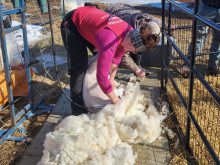RED DEER – A new shoeing technique may be just what the doctor ordered for horses suffering from laminitis.
Sandy Loree, who works in the farrier program at Olds College in Olds, Alta., has developed a special pad and shoe system to relieve suffering in horses with this foot disorder.
His invention is a sole support consisting of several parts.
A compound similar to dental putty is pressed onto the bottom of the foot, which provides a cushion up to the rim of the hoof. A special pad and shoe is then attached.
Read Also

Charges laid after cattle theft
Saskatchewan RCMP lay two charges against a man after six cattle went missing.
The pad is made of heavy rubber with a tire-like tread that provides traction. It covers the entire ground surface of the hoof and encloses the sole cover. Its centre portion covers the sole and frog area of the hoof and is fitted to the inner circumference of a metal horseshoe.
Laminitis, or founder, is an acute inflammation of the laminae, which includes the layers of tissue that attach the outer hoof to the coffin bones of the horse’s foot.
The coffin bone is the last bone in the skeletal leg.
The laminae tears away from the hoof wall, allowing the horse’s weight to move the coffin bone within the hoof. The bone may be pushed down into the sole of the foot, resulting in painful lameness.
It is difficult for horses to take weight off their feet because they don’t like to lie down. Fluids are trapped in the front of the foot similar to a blood blister under the fingernail.
Secondary problems can develop.
“Foundered feet have done some severe damage to the circulatory system, which will limit its long-term results as far as repair is concerned,” said Loree at an Alberta horse breeders conference in Red Deer, Jan 12-14.
Horses with acute laminitis are lame, depressed, off feed and reluctant to move. All feet are susceptible, but most often the weight-bearing front feet are affected.
While no one is sure what causes the condition, there are a number of triggers: obesity, green grass, colic, feed overload, stress, drug reactions, toxins, influenza, hormone imbalance, Cushing’s disease, diabetes, limb overload and concussion.
“It appears these triggering mechanisms seem to target the laminae specifically and cause that foot to fall apart,” Loree said.
He said the condition needs immediate attention from a vet and farrier. Otherwise, it risks becoming a chronic condition or results in deformed hoof bones.
The vet must go to the horse, because loading the horse into a trailer could worsen the condition.
The hoof wall can tear away in a few minutes and it can take a year to heal and grow back.
The first step is getting the weight off the horse’s feet.
The foot has to be drained and commercial poultices applied. There may not appear to be much fluid, but an abscess could appear if the area is not drained.
Remove the shoes and let the horse stand on soft ground. Hard ground or concrete is painful for the horse.
Some people use duct tape to attach a Styrofoam pad on the foot, which provides a cushion that conforms to the shape. of the sole and reduces the pressure points.
Loree recommends carefully trimming the hoof so that the sole touches the ground. This distributes weight over a greater area and allows the sole to develop a callus.
Loree recommends diligent care for a year because it takes that long for a new hoof to grow back. He suggests soft ground for the horse to move freely. Deep bedding encourages it to lie down and take the load off its feet.
The hoof line will grow about 2.5 centimetres after one to four months of treatment, and be attached to the coffin bone. Inflammation can reoccur at this time.
The horse will walk better after three to six months of treatment, but it can still reinjure its foot. Keep the hoof trimmed so it does not catch on anything and tear again.
Loree’s website is www.horseshoes.com/5sequine.

















